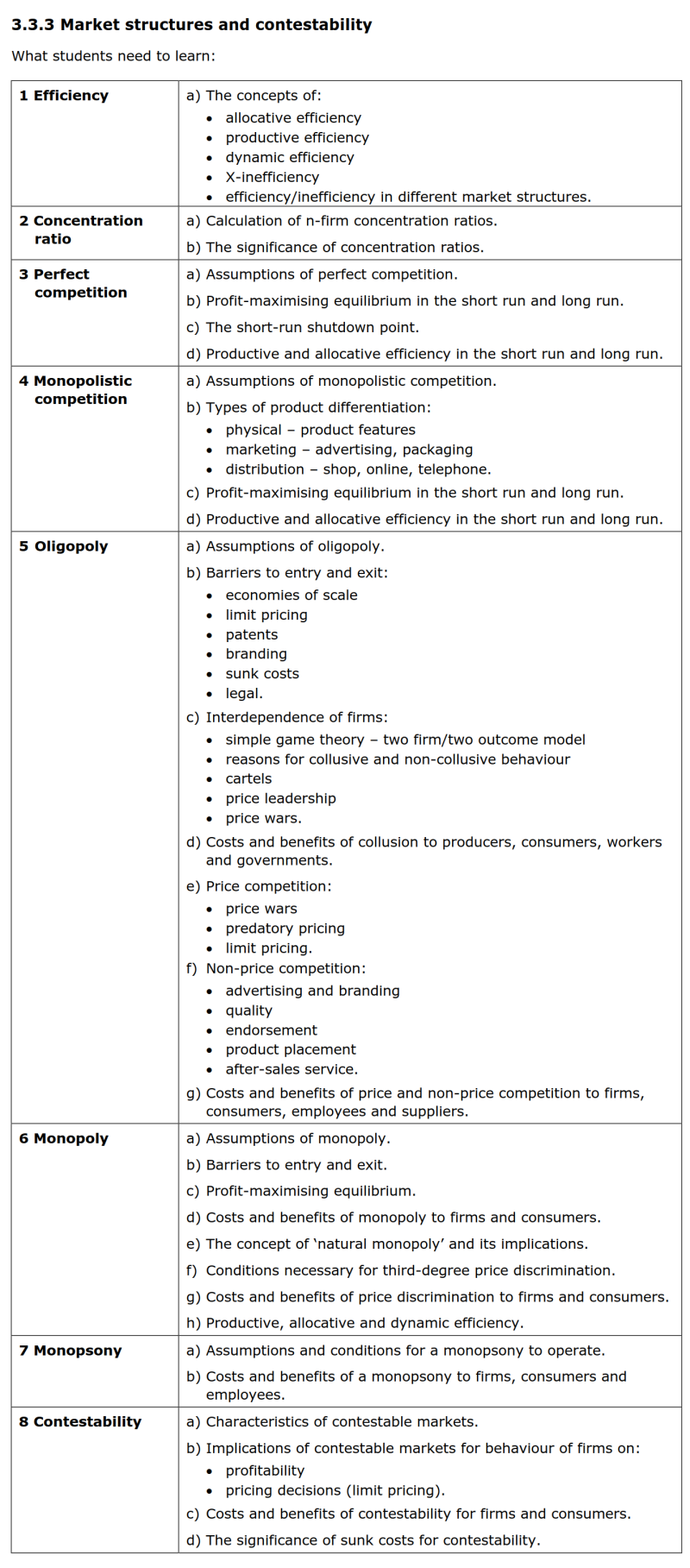Edexcel IAL U3 revision - Section 3 (2018)
如遇到公式加载异常,请刷新页面!
Section 3 Market structures and contestability 市场结构和可竞争性
- 大纲要求
1. Efficiency 效率
a) The concepts of: 掌握下列概念:
• allocative efficiency 分配效率
• productive efficiency 生产效率
• dynamic efficiency 动态效率
• X-inefficiency X无效率
• efficiency/inefficiency in different market structures. 不同市场结构中的效率或无效率
- productive efficiency:生产效率。企业以最低的平均成本进行生产。
- 竞争Competition能够促进企业去追求productive efficiency。如果不能达到足够低的成本,企业赚不到足够的利润,产品售价偏高也会导致消费者减少购买,最后会倒闭。
- productive efficiency的条件:MC=AC
- 在PPC中,PPC线上所有的点都满足productive efficiency的要求。因为按照PPC的定义,线上的点都是在用尽全部原材料后能达到的生产上限,所以符合成本最低的要求。
- 图中Y点满足productive efficiency,而X点则没有达到生产效率。
- 在PPC中,PPC线上所有的点都满足productive efficiency的要求。因为按照PPC的定义,线上的点都是在用尽全部原材料后能达到的生产上限,所以符合成本最低的要求。
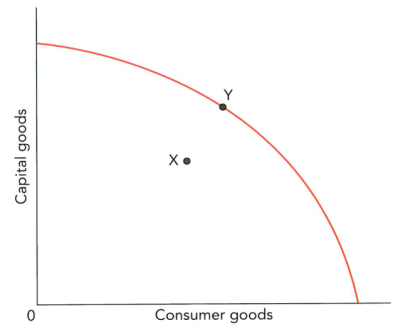
- 在成本线的图像中,MC线与AC线的交点所对应的产量满足productive efficiency的要求。
- 图中AC线的最低点X对应的产量Q即为满足productive efficiency时的产量。
- 在成本线的图像中,MC线与AC线的交点所对应的产量满足productive efficiency的要求。
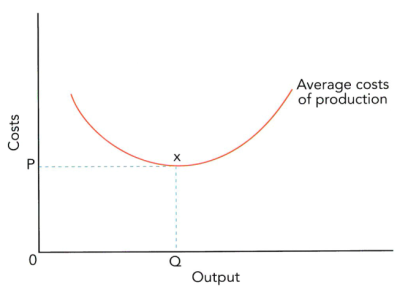
- allocative efficiency:分配效率。企业生产的数量能够充分满足消费者的需求,使其效用最大化。
- 竞争Competition也能够促进企业去追求allocative efficiency。如果不能迎合消费者的需求,生产出的东西将无人问津,会亏损。但如果迎合消费者,则会获得高额的利润。
- allocative efficiency的条件:MC=P或MC=AR
- 在PPC中,PPC与indifference curve相切的点满足allocative efficiency(如果相离则不存在allocative efficiency的位置,如果相切则PPC上仅有一点满足allocative efficiency)。这是由于生产需要贴合消费者的需求,所以需要兼顾生产与效用两条线。
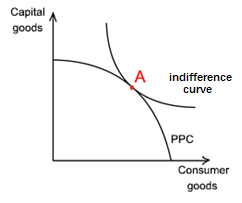
- 在收益-成本线的图像中,MC线与AR线的交点所对应的产量满足allocative efficiency的要求。
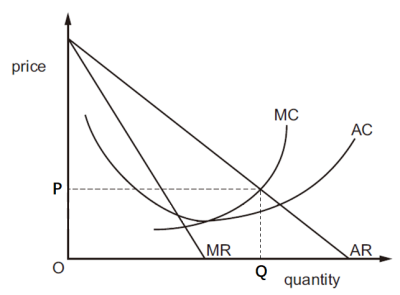
- dynamic efficiency:动态效率。企业通过诸如技术革新、研发等手段在长期内保持生产效率,达成资源的有效分配。
- 常见图像:
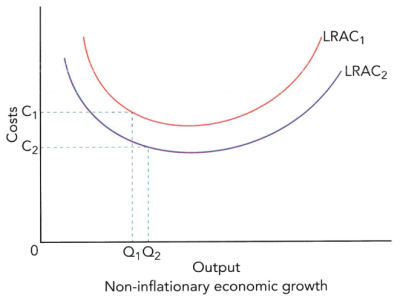
- 注意:dynamic efficiency保证的是企业在长期有生产效率,但因为研发的前期需要巨额投资,因此短期内成本很高,很难达成productive efficiency。
- X-inefficiency:企业在当前产量下,其生产成本高于竞争市场中的成本。
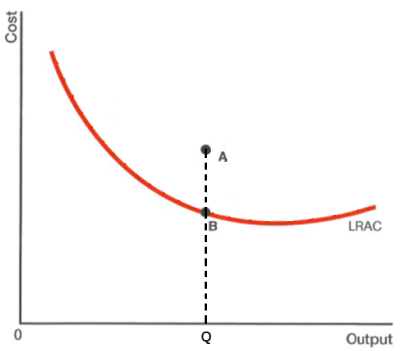
- 图中,产量为Q时成本最低的点为B点,该点是当前产量下最有效率的点,称为X-efficiency。(注意,仅是当前产量,而非长期最佳产量)而该产量下并非最低成本的点(如A点),则称为X-inefficiency。
- efficiency/inefficiency in different market structures 不同市场结构中的效率或无效率
- 【参考3.3.3-3、3.3.3-4、3.3.3-5、3.3.3-6】
2. Concentration ratio 集中率
a) Calculation of n-firm concentration ratios. 计算n家企业的集中率
- concentration ratio:集中率。计算市场内最大的前3~5家企业的市场份额,以初步判断market structure市场结构的指标。
- 计算公式:\(n-firm\space concentration\space ratio=\frac{market\space size\space of\space TOP\space n\space firms}{total\space size\space of\space market}\times 100\%\)
b) The significance of concentration ratios. 集中率的重要性
- concentration ratio集中率对市场结构不能进行准确的判定,只能大致推断。具体哪种类型还要看最大的这几家企业的市场份额具体情况。比如三个市场的concentration ratio都是80%。但一个市场的TOP 5的市场份额均是16%,这个市场大概率是个竞争性很强的市场;一个市场的TOP 5的市场份额分别为35%,30%,10%,3%,2%,这个市场大概率是个寡头市场;一个市场的TOP 5的市场份额分别是70%,4%,3%,2%,1%,这个市场大概率是个垄断市场。所以单从集中率这一个指标无法准确判断,需要结合其他指标。
3. Perfect competition 完全竞争
a) Assumptions of perfect competition. 完全竞争的假设
b) Profit-maximising equilibrium in the short run and long run. 短期和长期在利润最大化下的均衡
c) The short-run shutdown point. 短期倒闭点
d) Productive and allocative efficiency in the short run and long run. 短期和长期的生产效率与分配效率
4. Monopolistic competition 垄断性竞争
a) Assumptions of monopolistic competition. 垄断性竞争的假设
b) Types of product differentiation: 产品差异化的类型:
• physical – product features 产品——产品特性
• marketing – advertising, packaging 营销——广告、包装
• distribution – shop, online, telephone. 分销——商店、网购、电话
c) Profit-maximising equilibrium in the short run and long run. 短期和长期在利润最大化下的均衡
d) Productive and allocative efficiency in the short run and long run. 短期和长期的生产效率和分配效率
5. Oligopoly 寡头垄断
a) Assumptions of oligopoly. 寡头垄断的假设
b) Barriers to entry and exit: 进入门槛与退出门槛:
• economies of scale 规模经济
• limit pricing 限制性定价
• patents 专利
• branding 品牌
• sunk costs 沉没成本
• legal. 法律
c) Interdependence of firms: 企业间的相互依赖:
• simple game theory – two firm/two outcome model 简单的博弈论——两家企业/两种结果模型
• reasons for collusive and non-collusive behaviour 勾结与非勾结行为的原因
• cartels 卡特尔
• price leadership 价格领导
• price wars. 价格战
d) Costs and benefits of collusion to producers, consumers, workers and governments. 勾结行为对生产者、消费者、工人和政府的成本和收益
e) Price competition: 价格竞争:
• price wars 价格战
• predatory pricing 掠夺性定价
• limit pricing. 限制性定价
f) Non-price competition: 非价格竞争:
• advertising and branding 广告与品牌
• quality 质量
• endorsement 代言
• product placement 产品植入
• after-sales service. 售后服务
g) Costs and benefits of price and non-price competition to firms, consumers, employees and suppliers. 价格与非价格竞争对公司、消费者、雇员和供应商的成本和收益
6. Monopoly 垄断
a) Assumptions of monopoly. 垄断市场的假设
b) Barriers to entry and exit. 进入门槛与退出门槛
c) Profit-maximising equilibrium. 利润最大化下的均衡
d) Costs and benefits of monopoly to firms and consumers. 垄断对企业与消费者的成本和收益
e) The concept of ‘natural monopoly’ and its implications. “自然垄断”的概念及其影响
f) Conditions necessary for third-degree price discrimination. 三级价格歧视的必要条件
g) Costs and benefits of price discrimination to firms and consumers. 价格歧视对企业和消费者的成本和收益
h) Productive, allocative and dynamic efficiency. 生产效率、分配效率与动态效率
7. Monopsony 买方垄断
a) Assumptions and conditions for a monopsony to operate. 垄断企业的假设和条件
b) Costs and benefits of a monopsony to firms, consumers and employees. 垄断对公司、消费者和雇员的成本和收益
8. Contestability 可竞争性
a) Characteristics of contestable markets. 可竞争性市场的特征
b) Implications of contestable markets for behaviour of firms on: 可竞争性市场对企业以下行为的影响:
• profitability 盈利能力
• pricing decisions (limit pricing). 定价决策(限制性定价)
c) Costs and benefits of contestability for firms and consumers. 可竞争性对公司与消费者的成本和收益
d) The significance of sunk costs for contestability. 沉没成本对可竞争性的重要性
